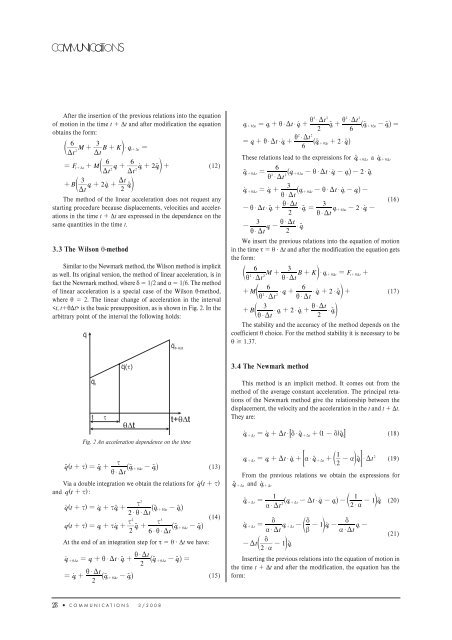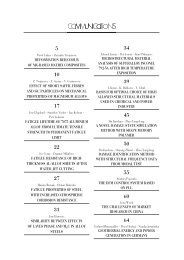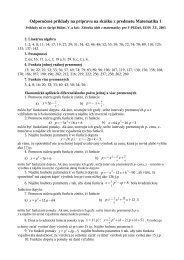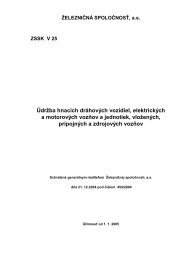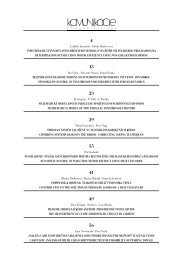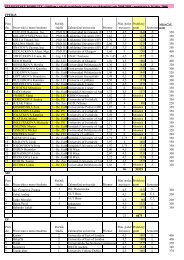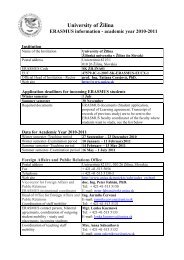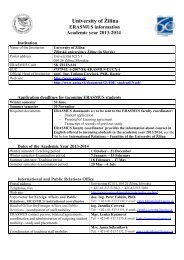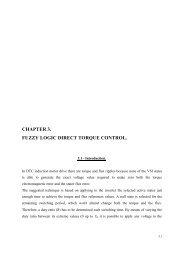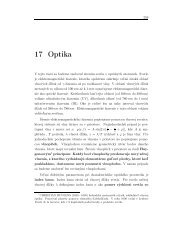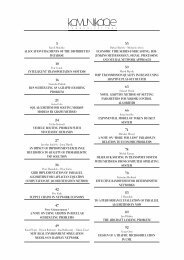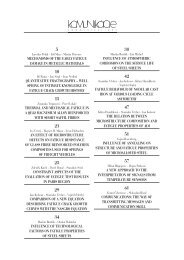simulation of torsion moment at the wheel set of the railway vehicle ...
simulation of torsion moment at the wheel set of the railway vehicle ...
simulation of torsion moment at the wheel set of the railway vehicle ...
Create successful ePaper yourself
Turn your PDF publications into a flip-book with our unique Google optimized e-Paper software.
After <strong>the</strong> insertion <strong>of</strong> <strong>the</strong> previous rel<strong>at</strong>ions into <strong>the</strong> equ<strong>at</strong>ion<strong>of</strong> motion in <strong>the</strong> time t Δt and after modific<strong>at</strong>ion <strong>the</strong> equ<strong>at</strong>ionobtains <strong>the</strong> form:6t M 3d +t B + K n $ q2t+Dt=D D6 6= F M q(12)t t q qt+ Dt+ d t+ ot+ 2ptn+2 2D D3Bt q q Dt + d t+ 2 ot+q ptnD2The method <strong>of</strong> <strong>the</strong> linear acceler<strong>at</strong>ion does not request anystarting procedure because displacements, velocities and acceler<strong>at</strong>ionsin <strong>the</strong> time t Δt are expressed in <strong>the</strong> dependence on <strong>the</strong>same quantities in <strong>the</strong> time t.3.3 The Wilson θ-methodSimilar to <strong>the</strong> Newmark method, <strong>the</strong> Wilson method is implicitas well. Its original version, <strong>the</strong> method <strong>of</strong> linear acceler<strong>at</strong>ion, is infact <strong>the</strong> Newmark method, where δ 1/2 and α 1/6. The method<strong>of</strong> linear acceler<strong>at</strong>ion is a special case <strong>of</strong> <strong>the</strong> Wilson θ-method,where θ 2. The linear change <strong>of</strong> acceler<strong>at</strong>ion in <strong>the</strong> interval is <strong>the</strong> basic presupposition, as is shown in Fig. 2. In <strong>the</strong>arbitrary point <strong>of</strong> <strong>the</strong> interval <strong>the</strong> following holds:2 2 2 2i $ Dt i $ Dtqt+ iDt = qt+ i $ Dt$qot+ q pt+ _ qpt+iDt- qpti=2 62 2i $ Dt= qt+ i $ Dt$qot+ _ qpt+iDt+2 $ qpti6These rel<strong>at</strong>ions lead to <strong>the</strong> expressions for qp t+iDta qot+iDt6qpt+ iDt = _ qt t-i$ Dt$ qt-qt -2$ q2 2 + iDo i pti $ Dt3qo qt q t q qt+ iDt = ot+ _ t+iDt-i$ D $ ot- ti-i $ D(16)i $ Dt3- i $ Dt$qp q2t q 2 qt+ $ pt = t+iDt- $ ot-i $ D3t q i $ Dt- t-$ qpti $ D 2We insert <strong>the</strong> previous rel<strong>at</strong>ions into <strong>the</strong> equ<strong>at</strong>ion <strong>of</strong> motionin <strong>the</strong> time τ θ ⋅ Δt and after <strong>the</strong> modific<strong>at</strong>ion <strong>the</strong> equ<strong>at</strong>ion gets<strong>the</strong> form:6t M 3d +t B + K n $ q F2 2t+ iDt = t+iDt+i $ D i $ D6 6+ Md$ qt+ $ qot+ 2 $ qptn+(17)2 2i $ Dti $ Dt3i $ Dt+ Be$ qt+ 2 $ qot+$ qptoi $ Dt2The stability and <strong>the</strong> accuracy <strong>of</strong> <strong>the</strong> method depends on <strong>the</strong>coefficient θ choice. For <strong>the</strong> method stability it is necessary to beθ 1.37.3.4 The Newmark methodThis method is an implicit method. It comes out from <strong>the</strong>method <strong>of</strong> <strong>the</strong> average constant acceler<strong>at</strong>ion. The principal ret<strong>at</strong>ions<strong>of</strong> <strong>the</strong> Newmark method give <strong>the</strong> rel<strong>at</strong>ionship between <strong>the</strong>displacement, <strong>the</strong> velocity and <strong>the</strong> acceler<strong>at</strong>ion in <strong>the</strong> t and t Δt.They are:Fig. 2 An acceler<strong>at</strong>ion dependence on <strong>the</strong> timexqt p^+ xh= qp (13)t q qt+ _ pt+iDt-ptii $ DVia a double integr<strong>at</strong>ion we obtain <strong>the</strong> rel<strong>at</strong>ions for qt o ^ + xhand qt ^ + xh:2xqt o^+ xh= qo qt q qt+ xpt+ _ pt+iDt-pti2 $ i $ D(14)2 3x xqt ^ + xh= q q q2 6 t q qt+ xot+ pt+ _ pt+iDt-pti$ i $ DAt <strong>the</strong> end <strong>of</strong> an integr<strong>at</strong>ion step for τ θ ⋅ Δt we have:i $ Dt qot+ iDt = qt+ i $ Dt$qpt+ _ q pt+iDt- q pti=2i $ Dt = qot+ _ q pt+iDt-q pti(15)2pq t+Dqo = qo + Dt$ 7d$qp + ^1-dhqpAt+ Dt t t+Dt tdqt q dq do1t qt+ Dt = t+Dt-e- o ot- t-a $ D b a $ Dd-Dtd-1nqpt2 $ a(18)12qt+ Dt = qt+ Dt$ qot+ = a$ qpt+Dt+ d -anqptG$ Dt(19)2From <strong>the</strong> previous rel<strong>at</strong>ions we obtain <strong>the</strong> expressions fort and qot+Dt11qpt+ Dt = _ qt t-Dt$qt-qt - -1qt(20)2 + Do i d npa $ Dt2 $ a(21)Inserting <strong>the</strong> previous rel<strong>at</strong>ions into <strong>the</strong> equ<strong>at</strong>ion <strong>of</strong> motion in<strong>the</strong> time t Δt and after <strong>the</strong> modific<strong>at</strong>ion, <strong>the</strong> equ<strong>at</strong>ion has <strong>the</strong>form:28 ● COMMUNICATIONS 3/2008


